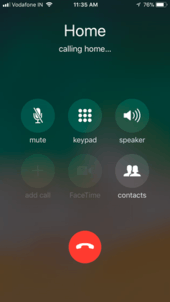FaceTime
 | |
| Developer(s) | Apple Inc. |
|---|---|
| Initial release |
|
| Stable release |
|
| Operating system |
|
| Platform | |
| Size | |
| Available in |
|
| Type |
|
| License | Commercial proprietary software |
| Website | |

FaceTime is a proprietary videotelephony product developed by Apple Inc. FaceTime is available on supported iOS mobile devices and Macintosh computers that run Mac OS X 10.6.6 and later. FaceTime supports any iOS device with a forward-facing camera and any Macintosh computer equipped with a FaceTime Camera. FaceTime Audio, an audio-only version, is available on any iOS device that supports iOS 7 or newer, and any Macintosh with a forward-facing camera running Mac OS X 10.9.2 and later. FaceTime is included for free in iOS and in macOS from Mac OS X Lion (10.7) onwards.[1]
Apple bought the "FaceTime" name from FaceTime Communications, who changed their name to Actiance, Inc.[2] Soon after, Apple CEO Steve Jobs announced FaceTime on June 7, 2010 in conjunction with the iPhone 4 in a keynote speech at the 2010 Apple Worldwide Developers Conference.
History
Apple bought the "FaceTime" name from FaceTime Communications, who changed their name to Actiance, Inc.[2]
Apple CEO Steve Jobs announced FaceTime on June 7, 2010 in conjunction with the iPhone 4 in a keynote speech at the 2010 Apple Worldwide Developers Conference.
Support for the fourth generation iPod Touch (the first model of iPod Touch equipped with cameras) was announced in conjunction with the device's release on September 8, 2010.
FaceTime for Mac OS X was announced on October 20, 2010 at the "Back to the Mac" Media event on the Apple Campus.
On March 2, 2011, FaceTime support was announced for the newly introduced iPad 2, which gained forward- and rear-facing cameras.
On February 24, 2011, FaceTime left beta and was listed in the Mac App Store for US$0.99. Apple claims that it intended to provide the application free of charge, however, a provision of the Sarbanes–Oxley Act (2002) bars companies from providing an unadvertised new feature of an already-sold product without enduring "onerous accounting measures".[3] As of December 2017, the US$0.99 beta is still available for download from Apple.[4] FaceTime is included for free in macOS from Mac OS X Lion (10.7) onwards and iOS.[1]
AT&T allowed customers to use FaceTime as long as they were tiered, but blocked the application from working for customers with unlimited data plans. They were brought before the Federal Communications Commission (FCC) for net neutrality violations.[5]
On May 2011, it was found that FaceTime would work seamlessly over 3G on all iPhone, iPad and iPod Touch models that supported it. Even though FaceTime worked only over 3G at that time, it now supports 4G LTE calls on networks all over the world, availability being limited to operators' GSM plans.[6]
In June 2018, Apple announced in the WWDC that FaceTime will support group video and audio calls with up to 32 people in iOS 12 and macOS Mojave.[7]
Implementation

FaceTime works by establishing a connection between two supported devices. Most Apple devices (such as iPhones, iPads and Macs) introduced after 2011 support FaceTime. FaceTime is currently incompatible with non-Apple devices or any other video calling services. Mac models introduced in 2011 introduced high-definition video FaceTime, which devices use automatically when both ends have a FaceTime HD camera.
Unlike Mac OS X's iChat, FaceTime currently does not support group conferencing but support has been announced for iOS 12. The application is a one-on-one video chat—only two people can talk at once. If a second user calls and the user answers, the video chat with the previous user ends and a new video session begins with the second caller. In iPhone, if a phone call is pending and the user attempts to answer, the video call ends and the phone call begins with the next user.
Incoming notifications on iOS devices are shown during a FaceTime call, but if they are opened, the video will be temporarily paused until the user is back in the FaceTime app.

On the iPhone, a user can activate FaceTime during a phone call by pressing the FaceTime button, or initiated FaceTime from their call history or the Contacts application. iOS 7 and newer also provide a separate FaceTime app, as there always has been on Apple's non-telephony devices: iPad, iPod Touch, and Mac.
Until the release of iOS 6, FaceTime required a WiFi connection to work. From iOS 6 onwards, FaceTime for the iPhone and iPad has supported FaceTime calls over cellular networks (3G or LTE) provided the carrier enabled it, which by mid-2013 virtually all carriers worldwide have allowed. FaceTime Audio uses about three megabytes of data for every five minutes of conversation, with FaceTime Video using significantly more.[8] Cellular talk time/minutes are not used after switching from a voice call to a FaceTime call.
FaceTime calls can be placed from supported devices to any phone number or email address that is registered to the FaceTime service. A single email address can be registered to multiple devices and a call placed to that address rings all devices simultaneously.
Standards
The FaceTime protocol is based on numerous open industry standards[9] although it is not interoperable with other videotelephony systems:
- H.264 and AAC-ELD – video and audio codecs respectively.
- SIP – IETF signaling protocol for VoIP.
- STUN, TURN and ICE – IETF technologies for traversing firewalls and NAT.
- RTP and SRTP – IETF standards for delivering real-time and encrypted media streams for VoIP.
Upon the launch of the iPhone 4, Jobs stated that Apple would immediately start working with standards bodies to make the FaceTime protocol an "open industry standard". While the protocols are open standards, Apple's FaceTime service requires a client-side certificate.[10]
FaceTime calls are protected by end-to-end encryption so that only the sender and receiver can access them. Apple cannot decrypt this data.[11]
Compared to most SIP implementations, Facetime adds techniques that enhance performance at the cost of breaking interoperability:[12] port multiplexing, SDP minimization and SDP compression.
FaceTime Audio
A new audio-only version of FaceTime, named FaceTime Audio, was announced during the annual Apple Worldwide Developers Conference (WWDC) keynote speech on June 10, 2013, and released with iOS 7 on September 18, 2013. As an audio-only version of FaceTime, it effectively makes the protocol into a voice over Internet Protocol (VoIP), that competes with other mainstream providers in the field, including Skype (Microsoft).
Based on the same AAC-LD audio protocol, the service provides high quality audio. The iOS 7 betas limited FaceTime Audio to calls placed on a Wi-Fi network (the same original limitation of the video version of FaceTime), but the final release has removed that restriction to allow it to work over 3G and LTE data connections, as is the case with most carriers and plans with regard to FaceTime with video. Like the video version, FaceTime Audio is currently only available between Apple devices. The feature is not available to run on the iPod Touch 4th generation as the device does not support iOS 7 or later. FaceTime streaming over cellular data is unavailable for the iPhone 4 and the iPad 2.[13]
Limited availability
By country
As of October 2016, FaceTime is not enabled on devices bought in the United Arab Emirates and Pakistan,[14] possibly due to regulations in these countries that restrict IP-based communications. In addition, on devices bought in China only FaceTime Audio is disabled, while FaceTime Video is available.[15] Devices bought outside these countries support both video and audio versions of FaceTime.[16] Although Egypt, Jordan, Qatar and Kuwait originally disabled FaceTime on the iPhone 4, they later re-enabled the feature through a carrier update for existing phone owners, and made it pre-enabled on any newly purchased iPhone. In March 2018, FaceTime is available for iPhones in Saudi Arabia upon updating to iOS 11.3.
By iOS version
As of April 16, 2014, FaceTime ceased working on earlier versions of iOS which had previously supported it (iOS 4, 5 & 6). This was because the client-side certificate used to authenticate a genuine Apple device with FaceTime servers (amongst other uses[17]) expired on that date. Apple chose not to release an update to this certificate for all devices for which a newer major iOS version (with a new, valid certificate) was available. Apple did release a minor update, to the certificate only, for all OS X versions which could run FaceTime, and also for earlier versions of iOS, but only for the small number of devices which could run FaceTime but which could not run a newer major version of iOS. The result of this policy was that almost all iOS users had to update the iOS version on their devices if they wished to continue using FaceTime.[18] (This limitation applied even to users of jailbroken devices since, even with a legally jailbroken device, it would have been not only difficult but also illegal to extract and install Apple's new certificate, without Apple's permission, in order to work around this issue.[19] )
References
- 1 2 "Deleting Apple apps on iOS 10? There's a catch". CNET. Retrieved 2016-12-08.
- 1 2 "Our name". Learn More. FaceTime Communications. Archived from the original on June 9, 2010. Retrieved June 7, 2010.
Apple has announced that it will use 'FaceTime' as the trademark for its new video calling application. Our agreement with Apple to transfer the FaceTime trademark to them comes as we are rebranding our company to better reflect our capabilities. This is an Apple app that should come with your apple product. We will be announcing a new name in the coming months.
- ↑ Macgasm. "Apple charges for FaceTime". Retrieved February 24, 2011.
- ↑ "Mac". Softpedia. link within last sentence "The page provides access to FaceTime 0.9 Build 92 version".
- ↑ AT&T v. FaceTime. "AT&T/FaceTime Case Study" (PDF).
- ↑ zaone "iOS 5.1.1 ne demonstreaza ca Apple va permite efectuarea de apeluri FaceTime prin 3G", "iDevice.ro", May 2011
- ↑ "Apple's FaceTime offers group chats for up to 32 people". Engadget. Retrieved 2018-06-05.
- ↑ "How much data does FaceTime audio calling use?". iPhoneFAQ. Retrieved July 7, 2016.
- ↑ Daniel Eran Dilger (June 8, 2010). "Inside iPhone 4: FaceTime video calling". AppleInsider. Retrieved June 9, 2010.
- ↑ Wright, Josh (July 9, 2010). "Special Look: Face Time (part 3: Call Connection Initialization)". Packetstan. Retrieved March 6, 2011.
- ↑ "iOS Security - iOS10 - March 2017" (PDF). Apple. March 2017. Retrieved 2017-09-02.
- ↑ Kielhofner, Kristian (September 20, 2013). "Apple's new Facetime - a SIP Perspective". Not Just AstLinux Stuff. Retrieved September 11, 2014.
- ↑ "Use FaceTime with your iPhone, iPad, or iPod touch".
- ↑ "Ufone: iPhone 6 now available on Ufone, for an amazing 3G experience".
- ↑ "FaceTime audio disabled in China".
- ↑ Ray, Bill (October 19, 2010). "Apple wipes smile off FaceTime in the Middle East". The Register. Retrieved October 19, 2010.
- ↑ "iOS Client Certificate Expiration - April 16, 2014". Chase Christian Blog. April 21, 2014. Retrieved February 24, 2016.
- ↑ "iOS 6 users no longer able to use FaceTime, iOS 7 upgrade required". TechRepublic. April 29, 2014. Retrieved February 24, 2016.
- ↑ "Can we fix Facetime on devices staying on iOS6 by backporting the new certificates from 6.0.6/7.1.1?". Reddit. April 26, 2014. Retrieved February 24, 2016.
